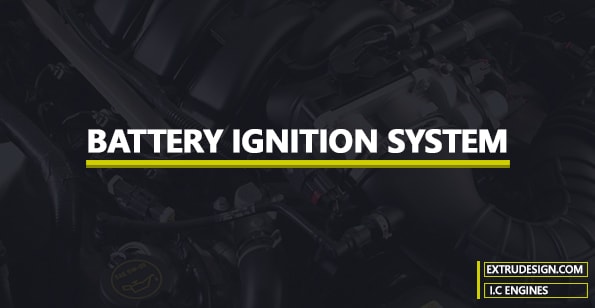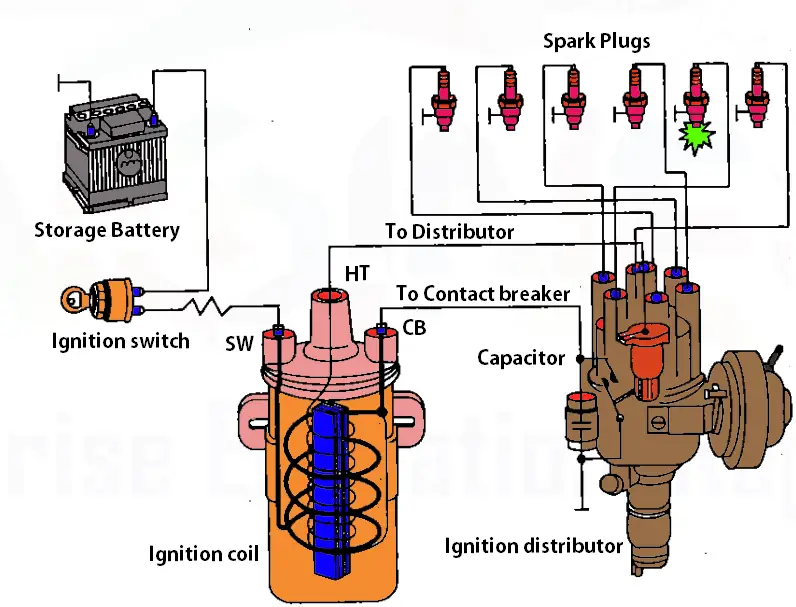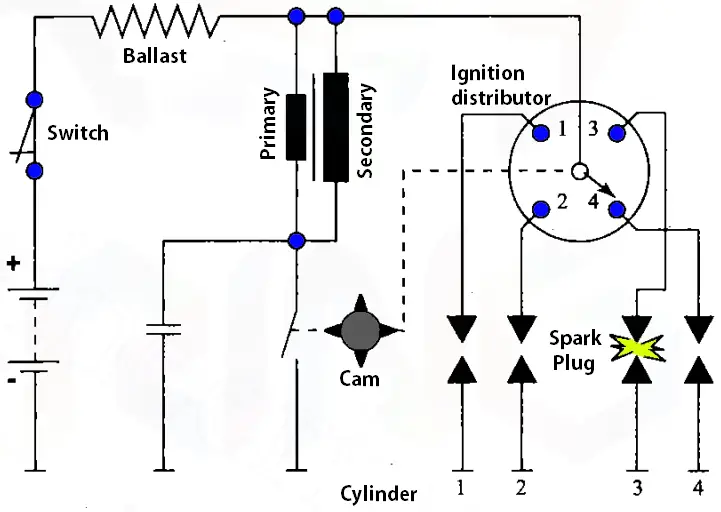In the current trend, most of the moderns SI engines run with the Battery Ignition system. In this system, the energy for producing the spark is obtained from a 6 volt or a 12-volt battery.

The Ignition system is said as the heart of the engine, and it is a part of the engine, not an independent one. It must be matched with the engine. so the construction of the battery Ignition system will be varied. It depends on the type of ignition energy storage and ignitions performance which is required by the particular engine.
Following are the list of essential components in the Ignition system
- Battery
- Ignition switch
- Ballast resistor
- Ignition coil
- Contact breaker
- Capacitor
- Distributor
- Spark plug
Construction of Battery Ignition System

A storage battery is used to supply and store the electrical energy for the ignition, this will be charged by the dynamo which is driven by the engine.
As you can see from the schematic diagram an Ignition switch is connected in the primary winding of the ignition coil to the ballast resistor. This is used to switch off/on the ignition.
A ballast resistor is connected in series to the Ignition switch to regulate the primary current.
An ignition coil is a source for the ignition energy in the Ignition system. This coil stores the energy and delivers at the right time in the form of ignition pulse through the high tension ignition cables to the respective spark plug.
A contact breaker is a mechanical device for making and breaking the primary circuit of the ignition coil. It will be operated by a cam operated pivoted arm.
There is an Ignition Capacitor which is the same as every electrical capacitor. Two metal plates separated by an insulating material are placed face to face.
A Distributor is connected in the circuit to distribute the ignition pulse to the individual spark plugs in the correct sequence and at the correct instants.
The spark plug is the one which catches the ignitions pulse and creates the spark by two electrodes placed with sufficient gap between them.
Operation of Battery Ignition system
The Ignition coil is the source for the ignition energy in the battery ignition system. It will deliver the ignition energy in the form of a surge of the high voltage current to the spark plug. See the following schematic representation the battery ignition system circuit for the four-stroke engine.

- There are two winding of the coil. one is called the primary and the other one is secondary.
- The primary winding is connected to the position terminal of the storage battery with the ignition switch and the ballast in series.
- On the other end of the primary winding is connected to the contact breaker and to the ground.
- A capacitor is connected in parallel to the contact breaker as shown in the above figure. This is the primary circuit.
- The secondary winding will be connected to the ground through the contact breaker.
- The other end of the secondary coil will be connected through the distributor through the high tension ignition cables to the centre electrode of the spark plug.
- Once the switch closed, then the primary circuit will complete. Thus the primary current will flow through the primary coil and created the magnetic field on the core of the Ignition coil.
- a cam driven by the engine will be arranged to open the breaker points whenever an ignition discharge is required.
- The primary current will follow through the condenser and the condenser will be charged.
- Once the condenser is charged then the primary current flow will be stopped, due to that the magnetic field also collapses.
- The collapse of the magnetic field will cause a voltage in the primary winding which charges the condenser to a voltage higher than the storage battery voltage.
- Then the condenser will start discharge the voltage into the battery by reversing the primary current direction and the magnetic field.
- This rapid collapse of the magnetic field and reversing in the direction will result in very high voltage in the secondary winding of the ignition coil.
- This high amount of voltage will be lead to the proper spark plug by the distributor.
- The timing of the spark will be controlled by the crank angle at which the breaker points open.
This is how the battery ignition will work.
Limitations of a Battery Ignition system
- The primary voltage will decrease as the engine speed increases due to the current switching capability of the breaker system.
- The time available for the build-up of current in the primary current will be decreased if the engine speed increases due to the dwell period become shorter.
- short maintenance interval due to involving o the mechanical means such as the contact breaker and the cam operations. these parts may wear.
Conclusion
We have discussed the Battery Ignition systems with the schematic representations and the operations. If you have any further thoughts on this topic, let us know in the comment section below.
Read the full article about Ignition systems here!

WHEN WAS THIS WRITTEN 1972? LAWNMOWERS DONT EVEN USE THIS SYSTEM ANYMORE!
Good sense of humor Charles. This article gives information on how it used to work in the past… Not to build one in 2022.
Anyway, thank you for your comment. keep reading.